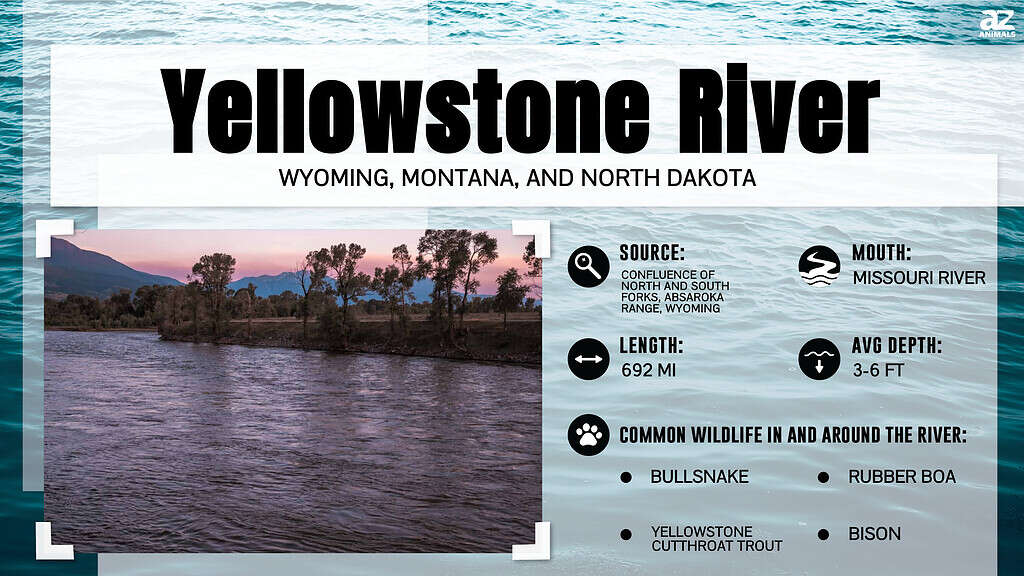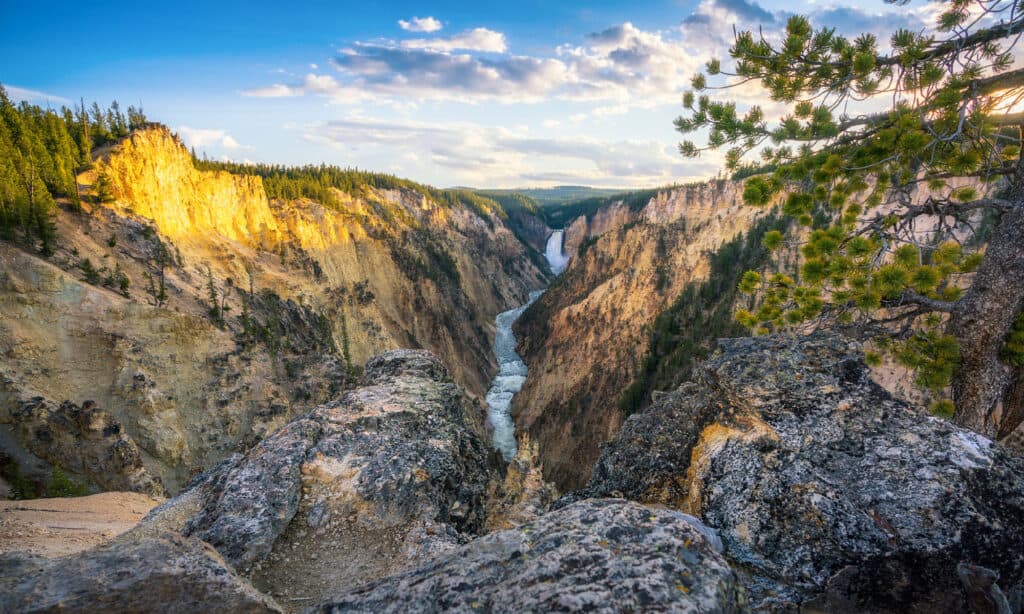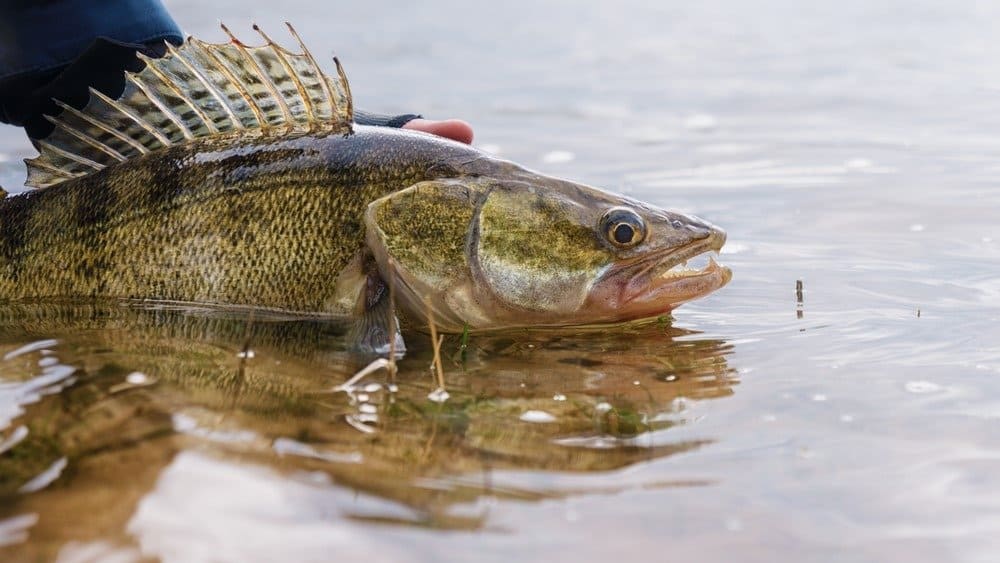Named after the yellow-colored rocks along stretches of the river, the Yellowstone River is one of the most scenic waterways in the United States. The river has a captivating history and serves an important function to the people and animals who live within and around its borders.
In this article, we will discover how wide the Yellowstone River is at its widest point, the volume, and the wildlife that calls the Yellowstone River home.

How Wide is the Yellowstone River at its Widest Point?
At its widest point, the Yellowstone River measures around 300 feet wide. The width of the Yellowstone River varies depending on the time of year and the amount of rainfall near the river’s source. While some areas are no more than 75 feet wide, most sections of the river measure around 200 feet wide.
The river stretches nearly 692 miles from its source in northwestern Wyoming to its terminus in western North Dakota. This makes the Yellowstone River the longest undammed river in the contiguous United States.
How Large is the Yellowstone River in Volume?

The Yellowstone River measures 300 feet wide at its widest point.
©iStock.com/ChrisB
Multiple variables can affect river discharge volume, including a change in landscape, weather, erosion, and groundwater flow. These factors also affect the tributaries which feed into the Yellowstone River. All of these factors make calculating discharge across an entire river system extremely difficult.
As a result, most measurements of river volume focus on a single point in the river system. The U.S. Geological Survey records the daily flow data of the Yellowstone River at several gaging stations, including ones in Sidney, Montana, and Corwin Springs, Montana. The data shows peak flows occur during spring runoff when the snowpack in the Rocky Mountains melts.
Around Corwin Springs, the Yellowstone River discharges, on average, around 16,620 cubic feet per second at its peak. During exceptionally wet years with higher-than-average snowfall, peak discharge can top 18,400 cubic feet per second. On the flip side, the river only discharges around 660 cubic feet per second during periods of low daily flow.
The Yellowstone River undergoes many changes on its course from Wyoming through Montana and into North Dakota. Over that time, it traverses steep-walled canyons, plummets down waterfalls, and flows lazily alongside fields. As the longest free-flowing river in the contiguous United States, the Yellowstone River is a pristine example of how a river operates.
Which Main Tributaries Supply the Yellowstone River?
The Yellowstone River begins in northwestern Wyoming in the Absaroka Range, a subrange of the Rocky Mountains. It begins at the place where the North Fork and South Fork converge to form the Yellowstone River. The North Fork originates from Younts Peak, the highest point in the Teton Wilderness, while the South Fork flows from Thorofare Mountain. Several tributaries feed into the Yellowstone River at different points along its length, including the Clarks Fork Yellowstone, Wind River, Bighorn River, Tongue River, and Powder River.
The Clarks Fork Yellowstone River measures 150 miles long. It starts in the Gallatin National Forest in the Beartooth Mountains of southern Montana and meets the Yellowstone River approximately 2 miles southeast of Laurel, Montana.
The 185-mile Wind River and Bighorn River are actually part of the same river system. People refer to the upper reaches of the waterway as the Wind River and the lower reaches as the Bighorn River. Their headwaters begin at Wind River Lake in the Rocky Mountains in west central Wyoming. The Wind River officially becomes the Bighorn River at the Wedding of the Waters, just outside Thermopolis, Wyoming. It ends approximately 50 miles from Hardin, Montana, once it meets up with the Yellowstone River.
The Tongue River begins in the Big Horn Mountains in northwestern Wyoming. It flows northeast for 265 miles until it empties into the Yellowstone River at Miles City, Montana.
The Powder River is the last of the Yellowstone River’s major tributaries. It flows for 375 miles from its headwaters in northeastern Wyoming until it meets the Yellowstone River in southeastern Montana. Like the Tongue River, the Powder River also meets the Yellowstone River just outside of Miles City, Montana.
How Large is the Yellowstone River Watershed?
The Yellowstone River watershed contains the Yellowstone River and all of its principal and minor tributaries and their associated water systems. In total, the river basin spans nearly 37,167 square miles and covers much of northwestern Wyoming, southern and eastern Montana, and western North Dakota. In addition to rivers, the watershed also contains many lakes, including Yellowstone Lake, Bull Lake, and Bighorn Lake.
How Does the Yellowstone River Compare to the Missouri River?

The Missouri River is the longest in the United States.
©LanaG/Shutterstock.com
The Yellowstone River is the longest undammed river in the contiguous United States. That said, the Missouri River is the longest river in the United States. It measures approximately 2,341 miles long from its source to the point where it enters the Mississippi River. In addition to measuring much longer than the Yellowstone River, the Missouri River is also much more voluminous. On average, it discharges nearly 87,520 cubic feet per second and can discharge up to 750,000 cubic feet per second.
Wildlife in the Yellowstone River

You can find the walleye in Yellowstone River.
©wwwarjag/Shutterstock.com
Many different animals rely on the Yellowstone River for food and shelter. Dozens of fish species call the river home, and just as many birds and mammals frequent its waters. Hers are some of the fish, birds, amphibians, and mammals that you can commonly find along the Yellowstone River:
- Rocky Mountain whitefish
- Utah chub
- Arctic Grayling
- Rainbow trout
- Cutthroat trout
- Brown trout
- Blue sucker
- Walleye
- Smallmouth bass
- Channel catfish
- Shovelnose sturgeon
- Sauger
- Bald eagles
- Cougars
- Bison
- White-tail deer
- Black bears
- Pronghorn
- Grizzly bears
The Yellowstone River boasts many native fish species, including the Arctic grayling, cutthroat trout, and Utah chub. However, you can also find non-native species along the river, such as brown trout and rainbow trout. These species have significantly impacted the river’s ecology and reduced the number of native fish. Today, regulations exist to restrict the fishing of native species to protect their dwindling numbers.
Why is the Yellowstone River Vital?
The Yellowstone River has served as an important waterway for centuries. The area encompassing the Big Horn, Power, and Tongue Rivers served as the summer hunting grounds for several Native American tribes, including the Cheyenne, Crow, Cree, and Lakota Sioux.
In fact, the name Yellowstone likely comes from a Minnetaree Indian name, Mi tse a-da-zi, which translates roughly to “yellow rock river.” This name likely stems either from the yellow-colored rocks commonly found in the river, or the yellow sandstone bluffs that surround the lower section of the river.
The discovery of gold near Virginia City, Montana, in 1860 prompted mass migration to the region. Many settlers used the river for transportation and also for the delivery of goods. Several expeditions that explored the area now devoted to Yellowstone National Park traveled along the Yellowstone River. These included the Cook-Folsom-Peterson Expedition and Washburn-Langford-Doane Expedition.
Today, many anglers consider the Yellowstone River one of the world’s greatest trout fishing streams. Since the river lacks dams, trout can congregate in large numbers along the river. The river is home to non-native species like the rainbow trout and endangered endemic species like the pallid sturgeon.
Where is Yellowstone River Located on a Map?
Stretching about 692 miles in the Western United States, the Yellowstone River serves as a significant tributary of the Missouri River.
Here is Yellowstone River on a map:
The photo featured at the top of this post is © Cavan-Images/Shutterstock.com
Thank you for reading! Have some feedback for us? Contact the AZ Animals editorial team.






